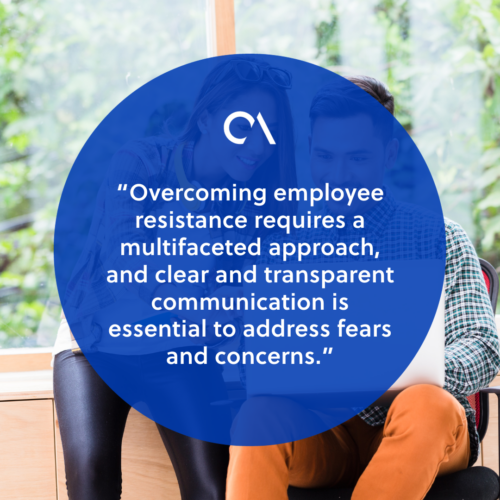Empowerment in the workplace and why it is important

A detrimental cycle often emerges when employees are overworked and lack empowerment in the workplace.
Over time, the strain of excessive workload without the authority or autonomy to make decisions can lead to burnout.
Burnout manifests as physical and emotional exhaustion, reduced productivity, increased absenteeism, and a heightened risk of mental health issues among employees.
Employee morale declines, turnover rates rise, and the organization faces challenges in attracting and retaining top talent.
Another contributing factor to high employee churn is having a toxic work environment.
A recent poll from Netsuite found that 74% of participants had experienced a decline in their work performance due to toxic work practices.
On the other hand, employees perform at their best when there is empowerment in the workplace.
Empowered employees are likelier to feel a sense of ownership over their work, leading to increased job satisfaction, motivation, and a higher output quality.
This article explores the significance of employee empowerment, empowering leadership styles, and successful workplace empowerment examples.
What is empowerment in the workplace?
Empowerment in the workplace refers to a management and leadership approach that involves granting employees the authority, autonomy, and responsibility to make decisions.
It is a fundamental concept that seeks to move beyond traditional hierarchical structures.
This means that top management creates an environment where employees are confident and free to contribute their expertise to the organization.
When empowerment in the workplace is set up inside the organization, leaders take action to assign only relevant work tasks and responsibilities to their team.
When employees feel empowered, they are more engaged, motivated, and confident in their abilities to contribute meaningfully to the organization’s goals.

Benefits of empowerment in the workplace
Empowerment in the workplace offers several benefits that go far beyond traditional management approaches.
Motivates employees to take initiative
Empowerment in the workplace is a powerful motivator for employees to take the initiative proactively.
When individuals feel that their opinions and contributions hold weight within the organization, it instills a sense of ownership and accountability over their work.
This ownership, in turn, drives employees to do the following favorable actions:
- Actively seek out opportunities
- Identify potential improvements
- Take charge of addressing workplace challenges
Empowered employees are not content with the status quo but are more inclined to seek innovative solutions and drive positive change proactively.
This intrinsic motivation to excel can profoundly impact overall productivity within the organization, as employees become enthusiastic contributors rather than passive observers.
A workplace that empower employees cultivates a thriving company culture built on trust, collaboration, and continuous growth.
Enhances creativity and innovation
Organizations cultivate an environment that nurtures creativity by setting up empowerment in the workplace.
When employees feel confident that their ideas will be considered and respected, they become more inclined to think outside the box and challenge the norm.
A creative atmosphere often leads to the development of groundbreaking products, services, and processes.
It also enables organizations to remain competitive in an ever-evolving market by continually adapting and staying at the forefront of industry trends.
Empowered employees lead to professional development by providing opportunities for growth and learning that translates to stronger job performance.
Boosts employee engagement
Empowerment in the workplace is intrinsically linked to employee engagement. It creates a symbiotic relationship that fosters a positive workplace culture.
When employees perceive that their voices matter and their contributions are valued, their engagement levels soar.
This heightened engagement manifests as a deep commitment to the organization’s mission and objectives.
Engaged employees are more likely to align their personal goals with the organization’s, resulting in increased loyalty and decreased turnover rates.
Reduced turnover translates to significant cost savings regarding recruitment, training, and the preservation of institutional knowledge.
Moreover, highly engaged employees tend to create a positive ripple effect within the workplace, inspiring their colleagues to invest their best efforts in their roles.
Improves decision-making capabilities
When employees across all levels are entrusted with decision-making authority within their areas of expertise, the organization gains access to diverse perspectives and expertise.
Decisions made by empowered employees often align with the organization’s overarching goals and values because they have a deeper understanding of the company’s mission.
When there is empowerment in the workplace, team members also have a heightened sense of responsibility.
Organizations benefit from quicker, more agile decision-making processes that swiftly respond to market changes and emerging opportunities.
How to implement empowerment in the workplace
Implementing empowerment in the workplace requires a thoughtful approach. Here are some key strategies to consider:
1. Delegate doable tasks
Begin by delegating tasks that employees can handle effectively. Ensure the tasks are well-defined and employees have the necessary skills and resources to complete them.
Gradually increase the complexity of delegated tasks as employees gain confidence and experience.
2. Offer guidance and resources
While empowering employees, providing guidance and access to resources is essential.
Offer training, mentoring, and support to help employees develop the skills and knowledge they need to excel in their roles.
Encourage them to seek guidance when necessary.
3. Encourage open and positive feedback
Create a culture of open communication and feedback. Encourage employees to share their ideas, concerns, and suggestions without fear of retribution.
Provide constructive feedback to help employees grow and improve in their roles.

Key empowering leadership styles and practices
Effective leadership plays a critical role in fostering empowerment in the workplace.
Here are some key leadership styles and practices that promote employee empowerment:
Transformational leadership
Transformational leaders are instrumental in shaping a workplace culture where empowerment in the workplace flourishes.
These leaders possess the unique ability to inspire and motivate their teams by setting a compelling vision for the future. They don’t merely manage; they lead by example.
This demonstrates an unwavering commitment to the organization’s goals and values.
Doing so creates a magnetic pull that encourages employees to align their aspirations with the collective vision.
One of the hallmarks of transformational leadership is its emphasis on fostering creativity and innovation.
These leaders are not content with the status quo; instead, they challenge conventional thinking and encourage employees to think outside the box.
Through dedicated leadership training programs, managers can hone their abilities to inspire and motivate their employees.
This approach empowers employees to take calculated risks and propose groundbreaking ideas that drive the organization’s growth and adaptability in a competitive market.
Moreover, this leadership style enables employees to see their full potential and gives them the confidence and support they need to reach new heights in their careers.
Participative decision-making
Participative decision-making is a leadership approach that recognizes the value of involving employees in the decision-making process.
Leaders who embrace this style create a workplace culture characterized by a sense of ownership and commitment among the workforce.
Employees feel valued and respected when their input is sought, leading to increased job satisfaction and a positive organizational culture.
When employees have a say in decisions that affect their work, they become more invested in the outcomes, fostering a deeper sense of responsibility and engagement.
This approach ensures that decisions are well-informed and consider diverse perspectives.
Participative leaders gain access to a wider range of insights and ideas by tapping into the team’s collective intelligence.
A diversity of thought leads to better decisions and a more comprehensive understanding of potential risks and rewards.
Servant leadership
Servant leadership represents a profound commitment to prioritizing the needs and well-being of employees.
These leaders adopt a selfless approach, focusing on serving and supporting their teams rather than wielding authority for its own sake.
By putting employees’ needs first, servant leaders cultivate empowerment in the workplace built on trust and empowerment. In a servant leadership framework, leaders act as facilitators, helping employees thrive personally and professionally.
This supportive approach fosters a culture where individuals feel safe to express their ideas and concerns.
Employees are likelier to take initiative and ownership of their work when they know their leaders genuinely care about their growth and well-being.
This mutual trust and respect create a powerful synergy that boosts employee morale and enhances organizational performance.
Challenges to overcoming barriers to empowerment in the workplace
While empowerment offers numerous benefits, organizations must address challenges to implement empowerment in the workplace successfully:
Resistance to change
Resistance to change is a common hurdle when implementing empowerment in the workplace.
Employees and even some leaders may resist shifting from traditional hierarchical structures to more empowered work environments.
It often stems from the fear of the unknown and a lack of trust in the new process.
Employees may worry about their ability to adapt to the changes or be concerned about potential negative consequences.
On the other hand, leaders may be apprehensive about relinquishing control or question whether employees are ready for increased responsibility.
Overcoming employee resistance requires a multifaceted approach, and clear and transparent communication is essential to address fears and concerns.
Employees need to understand the rationale behind empowerment and how it will benefit them and the organization.

Ensuring effective communication
Miscommunication can lead to misunderstandings, conflicts, and frustration among employees.
When expectations, roles, and responsibilities are not clearly defined or communicated, it can create confusion and hinder progress.
Poor communication can also erode trust and impede collaboration, essential to empowerment.
To address this challenge, organizations should invest in communication training and tools. Leaders and employees should have the skills to articulate their ideas, concerns, and expectations effectively.
Clear guidelines and channels for communication should be established to ensure that information flows freely and transparently.
Further, regular check-ins, feedback mechanisms, and open-door policies facilitate communication and allow employees to voice their opinions and suggestions.
Building trust among employees
Trust is the cornerstone of empowerment in the workplace, yet it can be challenging to establish and maintain. Building trust takes time and consistent effort.
Trust issues can stem from concerns about fairness, transparency, and the authenticity of leaders’ intentions.
Employees may initially be skeptical of empowerment initiatives, particularly if they have experienced the following:
- A lack of follow-through on promises
- Witnessed inconsistent leadership behavior in the past
- Consistently been deprived of attention and recognition
As such, leaders must be unwavering in their actions to demonstrate trustworthiness.
They should consistently uphold the principles of empowerment, follow through on commitments, and exhibit fairness in decision-making.
Examples of successful empowerment in the workplace
Here are two of the best examples of empowerment in the workplace:
Example #1
Imagine a tech startup where employees are encouraged to take ownership of their projects. They are free to experiment with new ideas and are given the necessary resources and support.
As a result, the company consistently develops innovative products and experiences high employee satisfaction and retention rates.
In this tech startup scenario, the company’s emphasis on empowering employees to take ownership of projects and experiment with new ideas has led to several significant implications.
Example #2
Consider a healthcare organization where nurses and other healthcare professionals are involved in decision-making.
They can suggest improvements in patient care and processes, leading to better patient outcomes and increased employee morale.
This shows that healthcare professionals’ ability to suggest improvements in patient care and processes results in better patient outcomes.
It also indicates that empowered employees are more likely to contribute to improved quality of care.







 Independent
Independent




